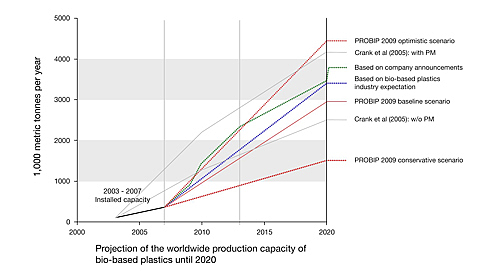The associations European Bioplastics and the European Polysaccharide Network of Excellence EPNOE published a jointly commissioned study on bio-based plastics today. Forecasts concerning capacity developments and technical substitution potentials are the focus of the investigations. The authors from Utrecht University estimate a substitution potential of up to 90 percent of the total consumption of plastics by bio-based polymers to be technically possible. How fast this substitution will occur depends on a multitude of factors.
New bio-based polymers have been available in the market for approximately one decade. Recently, standard polymers like polyethylene, polypropylene, PVC or PET, but also high-performance polymers like polyamide or polyester have been totally or partially substituted by their renewable raw materials equivalents. The starting raw materials are usually sugars or starches, partially also recycled materials from food or wood processing. In their study, Martin K. Patel, Li Shen and Juliane Haufe demonstrate that up to 90 percent of the current global consumption of polymers can technically be converted from oil and gas to renewable raw materials. Bio-based plastics will not substitute oil-based polymers in the near future for several reasons including low oil price, high production cost and restricted production capacity of biomass-based polymers that limit the technically possible growth of these plastics in the coming years, explains Patrick Navard, Chairman of the Governing Board of EPNOE.
Based on recent company announcements the production capacity of bio-based plastics is projected to increase from 360,000 tons in 2007 to about 2.3 million tons by 2013. This corresponds to an annual growth of 37 percent. We should keep a close eye on these figures, says Hasso von Pogrell, Managing Director of European Bioplastics. Important major projects were delayed in the years 2008 and 2009 due to the financial and economic crisis. Despite the still uncertain data, which of course has to be further consolidated, we deem such studies to be very essential. The role that lightweight conventional plastics played in the past, substituting durable materials like iron and steel in vast products, could soon be taken over by bio-based plastics. As the study shows, the potential is enormous, adds von Pogrell.
The study discusses for all major groups of bio-based plastics the production process, the material properties and the extent to which they could substitute petrochemical polymers from a technical point of view. Further aspects covered are the prices of these novel materials and their main producers. Three scenarios are distinguished to establish potential future growth trajectories, i.e. a baseline scenario, an optimistic and a conservative scenario. The results for these scenarios are also compared to the findings of a previous study made in 2005. The new study confirms that substantial technological progress has been made in bio-based plastics in the past five years. Innovations in material and product development, environmental benefits as well as the gradual depletion of crude oil increasingly call for polymers made from renewable raw materials.
Download study (1,5 MB)

| European Bioplastics: Melanie Gentzik Tel.: +49 (0) 30 28482 356 press@european-bioplastics.org | EPNOE: Julie Navard Tel.: +33 (0)4 93 95 74 89 julie.navard@epnoe.eu |




